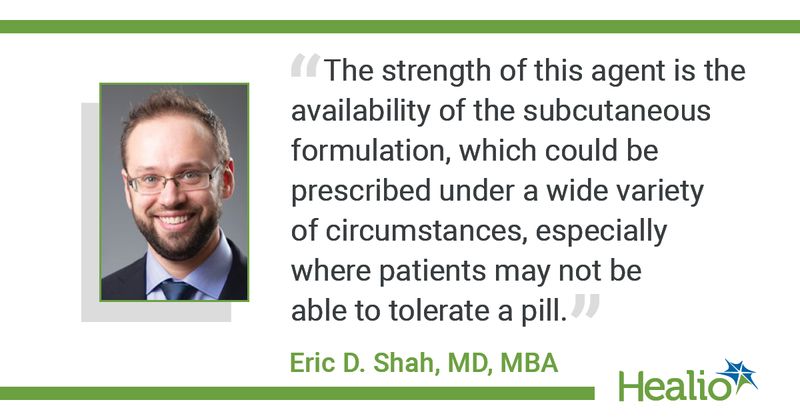Methylnaltrexone effectively treats opioid-induced constipation in patients with cancer
Methylnaltrexone can effectively treat opioid-induced constipation in patients, including those with cancer, according to research to be presented at the American Society of Regional Anesthesia and Pain Medicine’s annual meeting.
The research won the conference’s Best of Meeting Abstract Award.

“Subcutaneous methylnaltrexone is a well-known and established treatment for opioid-induced constipation,” Eric D. Shah, MD, MBA, director of the Gastrointestinal Motility, Esophageal, and Swallow Disorders Center at Dartmouth Hitchcock Medical Center in Lebanon, New Hampshire, told Healio Primary Care, adding that many physicians now refer to this condition as opioid-associated or opioid-exacerbated constipation in recognition that there may be other factors that predispose these patients to constipation.
“What hasn’t been known, until now, is how patients with cancer-related pain vs. noncancer-related pain in the clinical trials fared as separate groups,” he continued. “And that’s important because for patients who are taking opioids, they’re taking them for very different reasons in each of those cohorts.”
Shah and colleagues collated outcomes from two double-blind, randomized, placebo-controlled studies at multiple clinical sites to determine whether a subcutaneous formulation of methylnaltrexone could lead patients with advanced illness — with or without cancer — and opioid-induced constipation to achieve early rescue-free laxation.
In one trial — Study 302 — patients at 27 sites were randomly assigned to receive 0.15 mg/kg of methylnaltrexone or placebo daily for 2 weeks. A total of 78 patients with cancer were included, with 37 patients assigned to methylnaltrexone and 41 patients assigned to placebo. The researchers also enrolled 56 noncancer patients, with 26 assigned to methylnaltrexone and 30 assigned to placebo.
In the second trial — Study 4000 — patients were assigned to receive an 8-mg or 12-mg dose of methylnaltrexone based on their body weight or placebo for at least seven doses over 14 days. A total of 152 patients with cancer were included, of whom 79 were assigned to methylnaltrexone and 73 were assigned to placebo. Among the 78 noncancer patients who were enrolled, 37 were assigned methylnaltrexone and 41 were assigned placebo.
Shah and colleagues found that in both studies, there were significantly greater proportions of patients who achieved rescue-free laxation 4 hours after being given the first dose of methylnaltrexone vs. placebo, regardless of cancer status.
In Study 302, 51.4% of patients with cancer and 44% of noncancer patients who took methylnaltrexone achieved rescue-free laxation within 4 hours of the first dose compared with 14.6% of noncancer patients and 16.7% of patients with cancer in the placebo group. In Study 4000, 69.6% of patients with cancer and 70.3% of noncancer patients who took methylnaltrexone achieved rescue-free laxation compared with 15.1% of patients with cancer and 22% of noncancer patients who received placebo.
In both studies, the researchers also found that repeat dosing with methylnaltrexone maintained bowel symptoms response within 4 hours of treatment.
Among participants, the most common adverse events were abdominal pain, nausea and flatulence.
The researchers did not identify significant changes in pain scores between treatment and placebo groups in the studies.
Shah said that physicians can offer methylnaltrexone to help prevent adverse gastrointestinal events related to opioid treatment.
“We strive for our patients to stay healthy at home, have greater quality-of-life, and to need ERs and hospitals less,” he said. “If a patient with opioid-induced constipation is at risk for going to the hospital or an ER because of their GI illness, this is a treatment that works rapidly and potentially could help to prevent that.”
Shah added that “the strength of this agent is the availability of the subcutaneous formulation, which could be prescribed under a wide variety of circumstances, especially where patients may not be able to tolerate a pill.”

